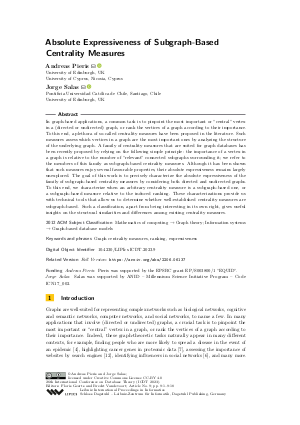Absolute Expressiveness of Subgraph-Based Centrality Measures
Authors
Andreas Pieris  ,
Jorge Salas
,
Jorge Salas 
-
Part of:
Volume:
26th International Conference on Database Theory (ICDT 2023)
Part of: Series: Leibniz International Proceedings in Informatics (LIPIcs)
Part of: Conference: International Conference on Database Theory (ICDT) - License:
 Creative Commons Attribution 4.0 International license
Creative Commons Attribution 4.0 International license
- Publication Date: 2023-03-17
File

PDF
LIPIcs.ICDT.2023.9.pdf
- Filesize: 0.79 MB
- 18 pages
Document Identifiers
Related Versions
- Full Version https://arxiv.org/abs/2206.06137
Subject Classification
ACM Subject Classification
- Mathematics of computing → Graph theory
- Information systems → Graph-based database models
Keywords
- Graph centrality measures
- ranking
- expressiveness
Metrics
- Access Statistics
-
Total Accesses (updated on a weekly basis)
0Document
0Metadata
Abstract
In graph-based applications, a common task is to pinpoint the most important or "central" vertex in a (directed or undirected) graph, or rank the vertices of a graph according to their importance. To this end, a plethora of so-called centrality measures have been proposed in the literature. Such measures assess which vertices in a graph are the most important ones by analyzing the structure of the underlying graph. A family of centrality measures that are suited for graph databases has been recently proposed by relying on the following simple principle: the importance of a vertex in a graph is relative to the number of "relevant" connected subgraphs surrounding it; we refer to the members of this family as subgraph-based centrality measures. Although it has been shown that such measures enjoy several favourable properties, their absolute expressiveness remains largely unexplored. The goal of this work is to precisely characterize the absolute expressiveness of the family of subgraph-based centrality measures by considering both directed and undirected graphs. To this end, we characterize when an arbitrary centrality measure is a subgraph-based one, or a subgraph-based measure relative to the induced ranking. These characterizations provide us with technical tools that allow us to determine whether well-established centrality measures are subgraph-based. Such a classification, apart from being interesting in its own right, gives useful insights on the structural similarities and differences among existing centrality measures.
Cite As Get BibTex
Andreas Pieris and Jorge Salas. Absolute Expressiveness of Subgraph-Based Centrality Measures. In 26th International Conference on Database Theory (ICDT 2023). Leibniz International Proceedings in Informatics (LIPIcs), Volume 255, pp. 9:1-9:18, Schloss Dagstuhl – Leibniz-Zentrum für Informatik (2023)
https://doi.org/10.4230/LIPIcs.ICDT.2023.9
BibTex
@InProceedings{pieris_et_al:LIPIcs.ICDT.2023.9,
author = {Pieris, Andreas and Salas, Jorge},
title = {{Absolute Expressiveness of Subgraph-Based Centrality Measures}},
booktitle = {26th International Conference on Database Theory (ICDT 2023)},
pages = {9:1--9:18},
series = {Leibniz International Proceedings in Informatics (LIPIcs)},
ISBN = {978-3-95977-270-9},
ISSN = {1868-8969},
year = {2023},
volume = {255},
editor = {Geerts, Floris and Vandevoort, Brecht},
publisher = {Schloss Dagstuhl -- Leibniz-Zentrum f{\"u}r Informatik},
address = {Dagstuhl, Germany},
URL = {https://drops.dagstuhl.de/entities/document/10.4230/LIPIcs.ICDT.2023.9},
URN = {urn:nbn:de:0030-drops-177516},
doi = {10.4230/LIPIcs.ICDT.2023.9},
annote = {Keywords: Graph centrality measures, ranking, expressiveness}
}
Author Details
Funding
- Pieris, Andreas: Pieris was supported by the EPSRC grant EP/S003800/1 "EQUID".
- Salas, Jorge: Salas was supported by ANID - Millennium Science Initiative Program - Code ICN17_002.
References
-
Renzo Angles, Marcelo Arenas, Pablo Barceló, Aidan Hogan, Juan L. Reutter, and Domagoj Vrgoc. Foundations of modern query languages for graph databases. ACM Comput. Surv., 50(5):68:1-68:40, 2017.

-
Phillip Bonacich. Power and centrality: A family of measures. American journal of sociology, 92(5):1170-1182, 1987.

-
Stephen P. Borgatti and Martin G. Everett. A graph-theoretic perspective on centrality. Soc. Networks, 28(4):466-484, 2006.

-
Zoltán Dezső and Albert-László Barabási. Halting viruses in scale-free networks. Phys. Rev. E, 65:055103, 2002.

-
Aidan Hogan, Andreas Harth, Jürgen Umbrich, Sheila Kinsella, Axel Polleres, and Stefan Decker. Searching and browsing linked data with SWSE: the semantic web search engine. J. Web Semant., 9(4):365-401, 2011.

-
Xinyu Huang, Dongming Chen, Dongqi Wang, and Tao Ren. Identifying influencers in social networks. Entropy, 22(4):450, 2020.

-
Gábor Iván and Vince Grolmusz. When the Web meets the cell: using personalized PageRank for analyzing protein interaction networks. Bioinformatics, 27(3):405-407, 2010.

-
Mitri Kitti. Axioms for centrality scoring with principal eigenvectors. Social Choice and Welfare, 46(3):639-653, 2016.

-
José-Lázaro Martínez-Rodríguez, Aidan Hogan, and Ivan López-Arévalo. Information extraction meets the semantic web: A survey. Semantic Web, 11(2):255-335, 2020.

-
Leonid Mirsky. Transversal Theory: An Account of Some Aspects of Combinatorial Mathematics. Academic Press, 1971.

-
Mark Newman. Networks. Oxford University Press, 2018.

-
Lawrence Page, Sergey Brin, Rajeev Motwani, and Terry Winograd. The pagerank citation ranking: Bringing order to the web. Technical Report 1999-66, Stanford InfoLab, 1999.

-
Richard Rado. Axiomatic treatment of rank in infinite sets. Canad. J. Math., pages 337-343, 1949.

-
Cristian Riveros and Jorge Salas. A family of centrality measures for graph data based on subgraphs. In ICDT, pages 23:1-23:18, 2020.

-
Gert Sabidussi. The centrality index of a graph. Psychometrika, 31(4):581-603, 1966.

-
Alfonso Shimbel. Structural parameters of communication networks. Bull. Math. Biophysics, 15:501-507, 1953.

-
Edward Szpilrajn. Sur l'extension de l'ordre partiel. Fundamenta Matematicae, 16:386-389, 1930.

-
René van den Brink and Robert P. Gilles. Measuring domination in directed networks. Social Networks, 22(2):141-157, 2000.

-
Tomasz Was and Oskar Skibski. Axiomatization of the pagerank centrality. In IJCAI, pages 3898-3904, 2018.

